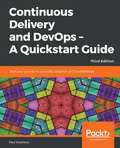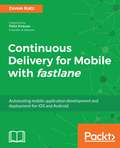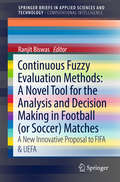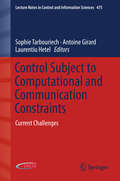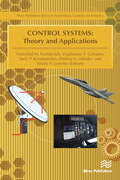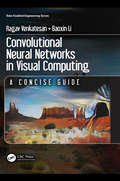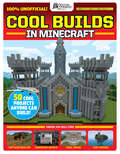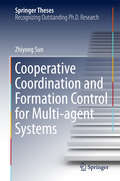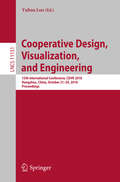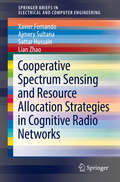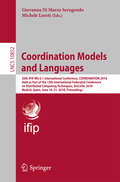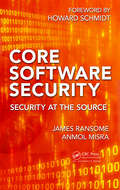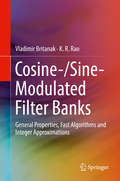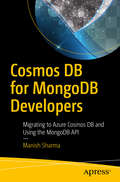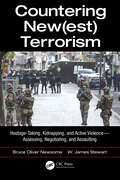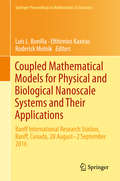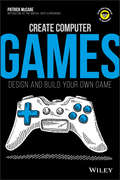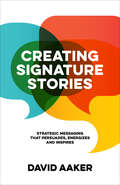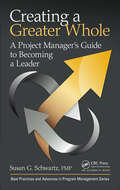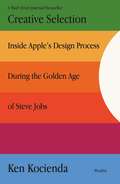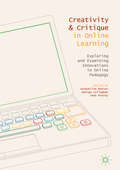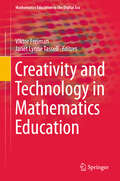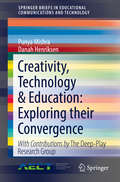- Table View
- List View
Continuous Delivery and DevOps – A Quickstart Guide: Start your journey to successful adoption of CD and DevOps, 3rd Edition
by Paul SwartoutDeliver quality software regularly and painlessly by adopting CD and DevOpsKey FeaturesIdentify and overcome the issues that stifle the delivery of quality softwareLearn how Continuous Delivery and DevOps work together with other agile toolsReal-world examples, tricks and tips that will help the successful adoption of CD & DevOpsBook DescriptionOver the past few years, Continuous Delivery (CD) and DevOps have been in the spotlight in tech media, at conferences, and in boardrooms alike. Many articles and books have been written covering the technical aspects of CD and DevOps, yet the vast majority of the industry doesn’t fully understand what they actually are and how, if adopted correctly they can help organizations drastically change the way they deliver value. This book will help you fiure out how CD and DevOps can help you to optimize, streamline, and improve the way you work to consistently deliver quality software. In this edition, you’ll be introduced to modern tools, techniques, and examples to help you understand what the adoption of CD and DevOps entails. It provides clear and concise insights in to what CD and DevOps are all about, how to go about both preparing for and adopting them, and what quantifiable value they bring. You will be guided through the various stages of adoption, the impact they will have on your business and those working within it, how to overcome common problems, and what to do once CD and DevOps have become truly embedded. Included within this book are some real-world examples, tricks, and tips that will help ease the adoption process and allow you to fully utilize the power of CD and DevOpsWhat you will learnExplore Continuous Delivery and DevOps in depthDiscover how CD and DevOps fits in with recent trends such as DataOps, SecOps, pipelines and CIUnderstand the root causes of the pain points within your existing product delivery processUnderstand the human elements of CD and DevOps and how intrinsic they are to your successAvoid common traps, pitfalls and hurdles as you implement CD and DevOpsMonitor and communicate the relative success of DevOps and CD adoptionExtend and reuse CD and DevOps approachesWho this book is forIf you are an IT professional, software developer, or system administrator who wants to understand how to ship quality software regularly, effectively and efficiently, this book is for you. Previous knowledge of DevOps practices, Continuous Delivery, or using DevOps tools is not necessary.
Continuous Delivery for Mobile with fastlane: Automating mobile application development and deployment for iOS and Android
by Kyle Mew Doron KatzLearn continuous deployment and automation with code-signing, continuous testing, building, deploying, and releasing of your app. Key Features A practical guide on automating your mobile development pipeline with Fastlane, Jenkins, and Slack. Build, test, run and deploy your mobile application release with this end to end guide. Implement Continuous Integration, delivery, and deployment practices to optimize your application development workflow for faster and efficient release builds. Book Description Competitive mobile apps depend strongly on the development team’s ability to deliver successful releases, consistently and often. Although continuous integration took a more mainstream priority among the development industry, companies are starting to realize the importance of continuity beyond integration and testing. This book starts off with a brief introduction to fastlane—a robust command-line tool that enables iOS and Android developers to automate their releasing workflow. The book then explores and guides you through all of its features and utilities; it provides the reader a comprehensive understanding of the tool and how to implement them. Themes include setting up and managing your certificates and provisioning and push notification profiles; automating the creation of apps and managing the app metadata on iTunes Connect and the Apple Developer Portal; and building, distributing and publishing your apps to the App Store. You will also learn how to automate the generation of localized screenshots and mesh your continuous delivery workflow into a continuous integration workflow for a more robust setup. By the end of the book, you will gain substantial knowledge on delivering bug free, developer-independent, and stable application release cycle. What you will learn Harness the fastlane tools for the Continuous Deployment strategy Integrate Continuous Deployment with existing Continuous Integration. Automate upload of screenshots across all device screen-sizes Manage push notifications, provisioning profiles, and code-signing certificates Orchestrate automated build and deployments of new versions of your app Regulate your TestFlight users and on-board new testersWho this book is for This book is intended for mobile developers who are keen on incorporating Continuous integration and deployment practices in their workflow.
Continuous Fuzzy Evaluation Methods: A Novel Tool for the Analysis and Decision Making in Football (or Soccer) Matches
by Ranjit BiswasThis book presents a proposal for a new soft computing innovative method called by “CFE” forevaluation of the football matches of FIFA(IFAB) and UEFA to compute the true ‘Winner’. It is a research work in the area of ‘Football Science’, being proposed to FIFA (IFAB) and UEFA, Zurich, Switzerland for consideration to replace the existing obsolete and weak rules of football matches of 90 minutes to declare the final ‘Winner’. In CFE, the final decision about any football match of 90 minutes is obtained “by computation”, by execution of a software called by ‘CFE-software’ with the real time input values directly from the field on a number of highly significant parameters, some of them being continuous variables. The result of m-n goals at the end of 90 minutes play in a football match is just one of the many parameters for the computation of the ‘Winner’ in our proposed CFE method. The evaluation is mainly based upon the application of Fuzzy Logic, ‘Fuzzy Pocket Machine’, fast Computer Server, good Communication system from playing-field to the server (as used in Cricket matches) and the CFE-software at the server. The Referees need not be experts in fuzzy set theory; they can be easily trained within just 30 minutes of demonstration on : how to use the ‘fuzzy pocket machine’ for giving real time inputs to the database at the server.
Control Subject to Computational and Communication Constraints: Current Challenges (Lecture Notes in Control and Information Sciences #475)
by Sophie Tarbouriech Laurentiu Hetel Antoine GirardThis book provides a broad overview of the current problems, challenges and solutions in the field of control theory, communication theory and computational resources management. Recent results on dynamical systems, which open new opportunities for research and challenges to be addressed in the future, are proposed in the context of computational and communication constraints. In order to take into the account complex phenomena, such as nonlinearities, time-varying parameters and limited availability of information, the book proposes new approaches for open problems with both theoretical and practical significance. The contributors’ research is centred on robust stability and performance of control loops that are subject to computational and communication constraints. A particular focus is placed on the presence of constraints in communication and computation, which is a critical issue in networked control systems and cyber-physical systems. The contributions, which rely on the development of novel paradigms are provided are by leading experts in the field from all over the world, thus providing readers with the most accurate solutions for the constraints. Control subject to Computational and Communication Constraints highlights many problems encountered by control researchers, while also informing graduate students of the many interesting ideas at the frontier between control theory, information theory and computational theory. The book is also a useful point of reference for engineers and practitioners, and the survey chapters will assist instructors in lecture preparation.
Control Systems: Theory and Applications (Studies In Systems, Decision And Control Ser. #203)
by Yuriy P. Kondratenko Vyacheslav F. Gubarev Vsevolod M. Kuntsevich Dmitriy V. Lebedev Vitaliy P. LysenkoIn recent years, a considerable amount of effort has been devoted, both in industry and academia, towards the development of advanced methods of control theory with focus on its practical implementation in various fields of human activity such as space control, robotics, control applications in marine systems, control processes in agriculture and food production.Control Systems: Theory and Applications consists of selected best papers which were presented at XXIV International conference on automatic control “Automatics 2017” (September 13-15, 2017, Kyiv, Ukraine) organized by Ukrainian Association on Automatic Control (National member organization of IFAC – International Federation on Automatic Control) and National University of Life and Environmental Sciences of Ukraine. More than 120 presentations where discussed at the conference, with participation of the scientists from the numerous countries. The book is divided into two main parts, a first on Theory of Automatic Control (5 chapters) and the second on Control Systems Applications (8 chapters). The selected chapters provide an overview of challenges in the area of control systems design, modeling, engineering and implementation and the approaches and techniques that relevant research groups within this area are employing to try to resolve these.This book on advanced methods of control theory and successful cases in the practical implementation is ideal for personnel in modern technological processes automation and SCADA systems, robotics, space and marine industries as well as academic staff and master/research students in computerized control systems, automatized and computer-integrated systems, electrical and mechanical engineering.
Convection in Ferro-Nanofluids: Physical Mechanisms, Flow Patterns, and Heat Transfer (Advances in Mechanics and Mathematics #40)
by Aleksandra A. Bozhko Sergey A. SuslovThis book covers the experimental and theoretical study of convection in non-isothermal ferro-nanofluids (FNFs). Since FNFs are not transparent and magnetic fields are very sensitive to the shape of the boundary between magnetic and nonmagnetic media, special flow visualization techniques based on the use of thermo-sensitive liquid crystal films, infrared cameras, as well as local and integral temperature sensors are discussed in the book. This book considers several major configurations of convective chambers and the applied magnetic field. For each of them, the stability boundaries are determined theoretically and experimentally. The physical types of dominant instabilities and the characteristics of their interactions are subsequently established using linear and weakly non-linear hydrodynamic stability analyses and elements of bifurcation theory. The book also discusses the potential of using magnetically controlled ferro-nanofluids as a heat carrier in situations where heat removal by natural convection is not possible due to the lack of gravity (orbital stations) or extreme confinement (microelectronics). Researchers and practitioners working in the areas of fluid mechanics, hydrodynamic stability, and heat and mass transfer will benefit from this book.
Convolutional Neural Networks in Visual Computing: A Concise Guide (Data-Enabled Engineering)
by Ragav Venkatesan Baoxin LiThis book covers the fundamentals in designing and deploying techniques using deep architectures. It is intended to serve as a beginner's guide to engineers or students who want to have a quick start on learning and/or building deep learning systems. This book provides a good theoretical and practical understanding and a complete toolkit of basic information and knowledge required to understand and build convolutional neural networks (CNN) from scratch. The book focuses explicitly on convolutional neural networks, filtering out other material that co-occur in many deep learning books on CNN topics.
Cool Builds in Minecraft!: An AFK Book (GamesMaster Presents)
by Future Future PublishingGet building today! This book is full of cool Minecraft projects and awesome advice that will help you become a master builder in no time.Get building today! For those who want to master the most important and most challenging aspect of Minecraft, GamesMaster Presents: Cool Builds in Minecraft! is the definitive book out there that covers mining resources to crafting buildings, vehicles and even entire worlds. Perfect for players of all ages who want to improve their crafting skills, this book will take you all the way from crafting your first shelter, to putting the finishing touches to your very own mega-build masterclasses. Includes full-color images and step-by-step instructions for 50 cool Minecraft builds. 100% unofficial. Created by Future plc and GamesMaster, leaders in video game publishing.
Cooperative Coordination and Formation Control for Multi-agent Systems (Springer Theses)
by Zhiyong SunThe thesis presents new results on multi-agent formation control, focusing on the distributed stabilization control of rigid formation shapes. It analyzes a range of current research problems such as problems concerning the equilibrium and stability of formation control systems, or the problem of cooperative coordination control when agents have general dynamical models, and discusses practical considerations arising during the implementation of established formation control algorithms. In addition, the thesis presents models of increasing complexity, from single integrator models, to double integrator models, to agents modeled by nonlinear kinematic and dynamic equations, including the familiar unicycle model and nonlinear system equations with drift terms. Presenting the fruits of a close collaboration between several top control groups at leading universities including Yale University, Groningen University, Purdue University and Gwangju Institute of Science and Technology (GIST), the thesis spans various research areas, including robustness issues in formations, quantization-based coordination, exponential stability in formation systems, and cooperative coordination of networked heterogeneous systems.
Cooperative Design, Visualization, and Engineering: 15th International Conference, CDVE 2018, Hangzhou, China, October 21–24, 2018, Proceedings (Lecture Notes in Computer Science #11151)
by Yuhua LuoThis book constitutes the refereed proceedings of the 15th International Conference on Cooperative Design, Visualization, and Engineering, CDVE 2018, held in Hangzhou, China, in October 2018. The 34 full papers presented in this book together with 15 short papers were carefully reviewed and selected from 75 submissions. The papers cover a broad range of topics in the field of cooperative visualization; cooperative design; cooperative engineering; basic theories, methods and technologies that support CDVE; and cooperative applications.
Cooperative Spectrum Sensing and Resource Allocation Strategies in Cognitive Radio Networks (SpringerBriefs in Electrical and Computer Engineering)
by Lian Zhao Xavier Fernando Ajmery Sultana Sattar HussainCognitive radio networks (CRN) will be widely deployed in the near future, and this SpringerBrief covers some important aspects of it, as well as highlighting optimization strategies in Resource Allocation and Spectrum Sensing in CRNs. The cognitive approach in radio access is introduced in the first part of this SpringerBrief, and then next the benefits of cooperative spectrum sensing are highlighted and a framework for studying it under realistic channel conditions is described. New exact closed-form expressions for average false alarm probability and average detection probability are derived in this scenario. A novel approximation to alleviate the computational complexity of the proposed models are also discussed.Once the spectrum opportunities are identified, efficient and systematic resource allocation (RA) shall be performed. The second part of this SpringerBrief describes the taxonomy for the RA process in CRN. A comprehensive overview of the optimization strategies of the CRN RA is also provided. The device-to-device (D2D) communication scenario is discussed, then as a case study and various optimization strategies for the application of the CR technology in the D2D realm is studied. The application of advanced geometric water-filling (GWF) approach in CRN D2D environment for optimum resource allocation is presented in detail. Numerical results provide more insight quantitatively. Overall, this book is suitable for a wide audience that include students, faculty and researchers in wireless communication area and professionals in the wireless service industry.
Coordination Models and Languages: 20th IFIP WG 6.1 International Conference, COORDINATION 2018, Held as Part of the 13th International Federated Conference on Distributed Computing Techniques, DisCoTec 2018, Madrid, Spain, June 18-21, 2018. Proceedings (Lecture Notes in Computer Science #10852)
by Michele Loreti Giovanna Di Marzo SerugendoThis book constitutes the proceedings of the 20th International Conference on Coordination Models and Languages, COORDINATION 2018, held in Madrid, Spain, in June 2018, as part of the 13th International Federated Conference on Distributed Computing Techniques, DisCoTec 2018.The 12 full papers included in this volume were carefully reviewed and selected from 26 submissions. The papers cover a wide range of topics and techniques related to system coordination, including: actor-based coordination, tuple- based coordination, agent-oriented techniques, constraints- based coordination, and finally coordination based on shared spaces.
Core Software Security: Security at the Source
by James Ransome Anmol Misra"... an engaging book that will empower readers in both large and small software development and engineering organizations to build security into their products. ... Readers are armed with firm solutions for the fight against cyber threats."—Dr. Dena Haritos Tsamitis. Carnegie Mellon University"... a must read for security specialists, software developers and software engineers. ... should be part of every security professional’s library." —Dr. Larry Ponemon, Ponemon Institute"... the definitive how-to guide for software security professionals. Dr. Ransome, Anmol Misra, and Brook Schoenfield deftly outline the procedures and policies needed to integrate real security into the software development process. ...A must-have for anyone on the front lines of the Cyber War ..." —Cedric Leighton, Colonel, USAF (Ret.), Cedric Leighton Associates"Dr. Ransome, Anmol Misra, and Brook Schoenfield give you a magic formula in this book - the methodology and process to build security into the entire software development life cycle so that the software is secured at the source! "—Eric S. Yuan, Zoom Video CommunicationsThere is much publicity regarding network security, but the real cyber Achilles’ heel is insecure software. Millions of software vulnerabilities create a cyber house of cards, in which we conduct our digital lives. In response, security people build ever more elaborate cyber fortresses to protect this vulnerable software. Despite their efforts, cyber fortifications consistently fail to protect our digital treasures. Why? The security industry has failed to engage fully with the creative, innovative people who write software.Core Software Security expounds developer-centric software security, a holistic process to engage creativity for security. As long as software is developed by humans, it requires the human element to fix it. Developer-centric security is not only feasible but also cost effective and operationally relevant. The methodology builds security into software development, which lies at the heart of our cyber infrastructure. Whatever development method is employed, software must be secured at the source. Book Highlights: Supplies a practitioner's view of the SDL Considers Agile as a security enabler Covers the privacy elements in an SDL Outlines a holistic business-savvy SDL framework that includes people, process, and technology Highlights the key success factors, deliverables, and metrics for each phase of the SDL Examines cost efficiencies, optimized performance, and organizational structure of a developer-centric software security program and PSIRT Includes a chapter by noted security architect Brook Schoenfield who shares his insights and experiences in applying the book’s SDL framework View the authors' website at http://www.androidinsecurity.com/
Cosine-/Sine-Modulated Filter Banks: General Properties, Fast Algorithms and Integer Approximations
by K. R. Rao Vladimir BritanakThis book covers various algorithmic developments in the perfect reconstruction cosine/sine-modulated filter banks (TDAC-MDCT/MDST or MLT, MCLT, low delay MDCT, complex exponential/cosine/sine-modulated QMF filter banks), and near-perfect reconstruction QMF banks (pseudo-QMF banks) in detail, including their general mathematical properties, matrix representations, fast algorithms and various methods to integer approximations being recently a new transform technology for lossless audio coding. Each chapter will contain a number of examples and will conclude with problems and exercises. The book reflects the research efforts/activities and achieved results of the authors in the time period over the last 20 years.
Cosmos DB for MongoDB Developers: Migrating to Azure Cosmos DB and Using the MongoDB API
by Manish SharmaLearn Azure Cosmos DB and its MongoDB API with hands-on samples and advanced features such as the multi-homing API, geo-replication, custom indexing, TTL, request units (RU), consistency levels, partitioning, and much more. Each chapter explains Azure Cosmos DB’s features and functionalities by comparing it to MongoDB with coding samples. Cosmos DB for MongoDB Developers starts with an overview of NoSQL and Azure Cosmos DB and moves on to demonstrate the difference between geo-replication of Azure Cosmos DB compared to MongoDB. Along the way you’ll cover subjects including indexing, partitioning, consistency, and sizing, all of which will help you understand the concepts of read units and how this calculation is derived from an existing MongoDB’s usage. The next part of the book shows you the process and strategies for migrating to Azure Cosmos DB. You will learn the day-to-day scenarios of using Azure Cosmos DB, its sizing strategies, and optimizing techniques for the MongoDB API. This information will help you when planning to migrate from MongoDB or if you would like to compare MongoDB to the Azure Cosmos DB MongoDB API before considering the switch.What You Will LearnMigrate to MongoDB and understand its strategiesDevelop a sample application using MongoDB’s client driverMake use of sizing best practices and performance optimization scenariosOptimize MongoDB’s partition mechanism and indexingWho This Book Is ForMongoDB developers who wish to learn Azure Cosmos DB. It specifically caters to a technical audience, working on MongoDB.
Countering New(est) Terrorism: Hostage-Taking, Kidnapping, and Active Violence — Assessing, Negotiating, and Assaulting
by Bruce Oliver Newsome James W. StewartHow should we analyze and assess new terrorist behaviors? What are the particular risks and challenges from new terrorism? Should we negotiate with terrorists, and, if so, how? When should we use force against terrorists? Countering New(est) Terrorism: Hostage-Taking, Kidnapping, and Active Violence—Assessing, Negotiating, and Assaulting improves our knowledge of new terrorist behaviors, and our skills in responding to such attacks.The term "new terrorism" has been in circulation since the late 90’s. This book analyzes the "newest terrorism" that has emerged in recent years—characterized by increased hostage-taking, kidnapping, and active violence—and develops best practices for countering these emerging threats. Along the way, it challenges fashionable wishful thinking that all terrorists are open to rational negotiation or de-radicalization, that military responses always reflect badly on the official side, and that terrorists are not constrained by their own doctrines.The new terrorists are dramatically more ideological, murderous, and suicidal. They are generally less reconcilable, less trusting of official negotiators, less likely to release detainees, and more likely to kill detainees. They are less likely to demand ransoms yet more likely to release hostages in cases in which they do demand ransom. They are more informed about the official side’s policies, tactics, techniques, and procedures. They are more likely to use new information and communication technologies against responding agencies and officials. They are more capable fighters—they kill more people despite deploying fewer fighters per hostage. Most disturbing is the fact that they take advantage of free-er societies to access easier targets. Features: Includes evidence-based definitions and descriptions of political, religious, Jihadi, and new terrorism Presents the first large-n comparison of old and new terrorism, using an original extension of the Global Terrorism Database (GTD), with added codes for each of 10,735 hostage crises and more than 500,000 data points from 1970 through 2016 Details a further extension of the GTD covering all terrorist events from 2004 through 2016, roughly 5 million data points. Offers prescriptive advice and visual decision trees on how to negotiate crises, assess the risk of terrorism, and how and when to assault terrorists Reviews official practices, interviews with experienced officials, and real-world simulations of recent terrorist events and attacks Countering New(est) Terrorism will be of interest to researchers, students enrolled in terrorism and Homeland Security programs, crisis negotiators, and police, security, intelligence, and military authorities tasked with counterterrorism and anti-terrorism efforts.
Coupled Mathematical Models for Physical and Biological Nanoscale Systems and Their Applications: Banff International Research Station, Banff, Canada, 28 August - 2 September 2016 (Springer Proceedings in Mathematics & Statistics #232)
by Roderick Melnik Luis L. Bonilla Efthimios KaxirasThis volume gathers selected contributions from the participants of the Banff International Research Station (BIRS) workshop Coupled Mathematical Models for Physical and Biological Nanoscale Systems and their Applications, who explore various aspects of the analysis, modeling and applications of nanoscale systems, with a particular focus on low dimensional nanostructures and coupled mathematical models for their description. Due to the vastness, novelty and complexity of the interfaces between mathematical modeling and nanoscience and nanotechnology, many important areas in these disciplines remain largely unexplored. In their efforts to move forward, multidisciplinary research communities have come to a clear understanding that, along with experimental techniques, mathematical modeling and analysis have become crucial to the study, development and application of systems at the nanoscale. The conference, held at BIRS in autumn 2016, brought together experts from three different communities working in fields where coupled mathematical models for nanoscale and biosystems are especially relevant: mathematicians, physicists (both theorists and experimentalists), and computational scientists, including those dealing with biological nanostructures. Its objectives: summarize the state-of-the-art; identify and prioritize critical problems of major importance that require solutions; analyze existing methodologies; and explore promising approaches to addressing the challenges identified. The contributions offer up-to-date introductions to a range of topics in nano and biosystems, identify important challenges, assess current methodologies and explore promising approaches. As such, this book will benefit researchers in applied mathematics, as well as physicists and biologists interested in coupled mathematical models and their analysis for physical and biological nanoscale systems that concern applications in biotechnology and medicine, quantum information processing and optoelectronics.
Create Computer Games: Design and Build Your Own Game
by Patrick McCabePUT DOWN YOUR CONTROLLER Why just play videogames when you can build your own game? Follow the steps in this book to learn a little about code, build a few graphics, and piece together a real game you can share with your friends. Who knows? What you learn here could help you become the next rock-star video- game designer. So set your controller aside and get ready to create! Decipher the code – build some basic knowledge of how computer code drives videogames Get animated – create simple graphics and learn how to put them in motion Update a classic – put your knowledge together to put your modern twist on a classic game
Create your Digital Marketing Agency - 14 tips to create your Online Marketing Agency
by Robinson Hardin María José Morales ClementeHow do I create my Online Marketing agency? Where do I start? How much money do I need to have? That is what all entrepreneurs of this Digital Era have asked themselves to start their Online Marketing Agency. With today's technology and access to the internet, a lot of doors are open. A whole world full of possibilities. This book will help you to know a little bit more through these 14 precise tips to start your Online Marketing Agency. Create and start to grow your brand, interact with clients, study your competition, these and a lot more for you to start your Digital Marketing business.
Creating Signature Stories: Strategic Messaging that Persuades, Energizes and Inspires
by David AakerStories are orders of magnitude which are more effective than facts at achieving attention, persuading, being remembered, and inspiring involvement. Signature stories—intriguing, authentic, and involving narratives—apply the power of stories to communicate a strategic message. Marketing professionals, coping with the digital revolution and the need to have their strategic message heard internally and externally, are realizing that a digital strategy revolves around content and that content is stories.Creating Signature Stories shows organizations how to introduce storytelling into their strategic messaging, and guides organizations to find, or even create, signature stories and leverage them over time. With case studies built into every chapter, organizations will realize the power of storytelling to energize readers, gain visibility, persuade audiences, and inspire action.
Creating a Greater Whole: A Project Manager’s Guide to Becoming a Leader (Best Practices in Portfolio, Program, and Project Management)
by Susan G. SchwartzCreating a Greater Whole unlocks the not-so-secret secrets of what aspiring managers need to become strong leaders. This information-rich, easy to understand guide offers readers an immediate clear path to honing their leadership skills using the rigor and discipline of project management principles. Topics include stakeholder management, collaborative communication, multi-criteria decision making, and conflict management. Reflective exercises in each chapter raise key questions for readers to craft their own development path. <P><P>The process invites emerging leaders to draw from their past experiences, recognize their intrinsic capabilities, and identify specific skills to cultivate.
Creative Selection: Inside Apple's Design Process During the Golden Age of Steve Jobs
by Ken Kocienda* WALL STREET JOURNAL BESTSELLER *An insider's account of Apple's creative process during the golden years of Steve Jobs.Hundreds of millions of people use Apple products every day; several thousand work on Apple's campus in Cupertino, California; but only a handful sit at the drawing board. Creative Selection recounts the life of one of the few who worked behind the scenes, a highly-respected software engineer who worked in the final years of the Steve Jobs era—the Golden Age of Apple. Ken Kocienda offers an inside look at Apple’s creative process. For fifteen years, he was on the ground floor of the company as a specialist, directly responsible for experimenting with novel user interface concepts and writing powerful, easy-to-use software for products including the iPhone, the iPad, and the Safari web browser. His stories explain the symbiotic relationship between software and product development for those who have never dreamed of programming a computer, and reveal what it was like to work on the cutting edge of technology at one of the world's most admired companies.Kocienda shares moments of struggle and success, crisis and collaboration, illuminating each with lessons learned over his Apple career. He introduces the essential elements of innovation—inspiration, collaboration, craft, diligence, decisiveness, taste, and empathy—and uses these as a lens through which to understand productive work culture.An insider's tale of creativity and innovation at Apple, Creative Selection shows readers how a small group of people developed an evolutionary design model, and how they used this methodology to make groundbreaking and intuitive software which countless millions use every day.
Creativity and Critique in Online Learning: Exploring and Examining Innovations in Online Pedagogy
by Jacqueline Baxter George Callaghan Jean McAvoyThis book explores emerging practices in distance education that have been facilitated by the development of educational technology. The volume examines core themes in distance education including online education at scale, embodiment in online environments, connectivity in online education and the personalisation of learning experiences within online education. The first section of the book examines online teaching tools, and explores how they are being used to enhance and promote student learning. The second looks at some of the broader challenges encountered by online teachers and those responsible for designing online learning material. While this volume will be of significant interest to distance learning universities and colleges, it will also be a valuable resource to traditional Higher Education Institutions, who are increasingly searching for innovative ways to reach and teach their students. This edited collection will be of value to scholars of online education as well as practitioners and policy makers looking to enrich their notions of online pedagogy.
Creativity and Technology in Mathematics Education (Mathematics Education in the Digital Era #10)
by Viktor Freiman Janet Lynne TassellThis volume provides new insights on creativity while focusing on innovative methodological approaches in research and practice of integrating technological tools and environments in mathematics teaching and learning. This work is being built on the discussions at the mini-symposium on Creativity and Technology at the International Conference on Mathematical Creativity and Giftedness (ICMCG) in Denver, USA (2014), and other contributions to the topic. The book emphasizes a diversity of views, a variety of contexts, angles and cultures of thought, as well as mathematical and educational practices. The authors of each chapter explore the potential of technology to foster creative and divergent mathematical thinking, problem solving and problem posing, creative use of dynamic, multimodal and interactive software by teachers and learners, as well as other digital media and tools while widening and enriching transdisciplinary and interdisciplinary connections in mathematics classroom. Along with ground-breaking innovative approaches, the book aims to provide researchers and practitioners with new paths for diversification of opportunities for all students to become more creative and innovative mathematics learners. A framework for dynamic learning conditions of leveraging mathematical creativity with technology is an outcome of the book as well.
Creativity, Technology & Education: Exploring their Convergence (SpringerBriefs in Educational Communications and Technology)
by Danah Henriksen Punya MishraIn this collection of beautifully written essays, Mishra, Henriksen, and the Deep-play Research Group challenge myths about technology and creativity, debate time-honored instructional practices, and play with new ideas for schools to care for and nurture, rather than constrain, creativity. These essays are provocative . . . refreshing, [and] insightful --Dr. Yong Zhao, Foundation Distinguished Professor, University of Kansas and Fellow, Mitchell Institute for Health and Education Policy, Victoria University, Australia. What is creativity? Why is it important? What does it look like across different disciplines and contexts? What role does technology play, if any, in the creative process? And finally, what do creativity and technology have to do with education? These are the questions that underlie the collection of articles in this book. These essays provide a broad analytic frame for thinking about creativity, technology and education and describe classroom examples as well as strategies for evaluating creative artifacts and creative environments. All of these are grounded in specific examples from across a wide range of disciplines and contexts--art, mathematics, engineering, computer science, graphic design, architecture, science to name just a few. The final essays take a broader perspective on creativity and technology focusing both on our highly inter-connected YouTube world but also possibilities for the future. Creativity, Technology & Education: Exploring their Convergence is a vital resource for educators and practitioners as they seek to incorporate creative work and thoughtful pedagogy in their personal and professional lives.
